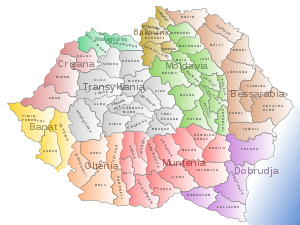
The Romanian expression România Mare (literal translation "Great Romania", but more commonly rendered "Greater Romania") generally refers to the Romanian state in the interwar period, and by extension, to the territory Romania covered at the time (see map). Romania achieved at that time its greatest territorial extent (almost 300,000 km2/120,000 sq mi), managing to unite all the historic Romanian lands. Historically, Greater Romania—România Mare - represented one of the ideals of Romanian nationalism. Greater Romania is still seen by many as a "paradise lost", often by comparison with the "stunted" Communist Romania. To exploit the nationalistic connotation of the term, a nationalist political party uses it as its name.
In 1918, at the end of World War I, Transylvania and Bessarabia united with the Romanian Old Kingdom. The Deputies of the Romanians from Transylvania voted to unite their region by the Proclamation of Union of Alba Iulia. Bessarabia, having declared its independence from Russia in 1917 by the Conference of the Country (Sfatul Ţării), called in Romanian troops to protect the province from the Bolsheviks who were spreading the Russian Revolution. The union of the regions of Transylvania, Maramureş, Crişana and Banat with the Old Kingdom of Romania was ratified in 1920 by the Treaty of Trianon, which recognised the sovereignty of Romania over these regions and settled the border between the independent Republic of Hungary and the Kingdom of Romania. The union of Bucovina and Bessarabia with Romania was ratified in 1920 by the Treaty of Versailles. Romania had also recently acquired the Southern Dobruja territory called "The Quadrilateral" from Bulgaria as a result of its participation in the Second Balkan War in 1913.
Proclamation of Union between Transylvania and Romania
Administrative map of Greater Romania in 1930. the colors represent the historical regions (no administrative value)
The Union of 1918 united most regions with clear Romanian majorities into the boundaries of a single state. However, it also led to the inclusion of various sizable minorities, including Magyars (ethnic Hungarians), Germans, Jews, Ukrainians, Bulgarians, etc., for a total of about 28% of the population (Magyars mostly in Transylvania; Germans in Transylvania, Bukovina, and Banat; Ukrainians in part of Bessarabia and Bukovina, Bulgarians in Dobrudja). Recognized by the Romanian Constitution of 1923 and supported by various laws (education, electoral, etc.), national minorities were represented in Parliament, and several of them created national parties (the Magyars in 1922, the Germans in 1929, the Jews in 1931), although a unique standing of minorities with autonomy on a wide basis, provided for at the assembly of Transylvanian Romanians on 1 December 1918 were not fulfilled.
Two periods can be identified in Romania between the two World Wars. From 1918 to 1938, Romania was a liberal constitutional monarchy, but one facing the rise of the nationalist, anti-semitic parties, particularly Iron Guard, which won about 15% of the votes in the general elections of 1937. From 1938 to 1944, Romania was a dictatorship. The first dictator was King Carol II, who abolished the parliamentary regime and ruled with his camarilla.
Romanian territory during the 20th century: purple indicates the Old Kingdom before 1913, orange indicates Greater Romania areas that joined or were annexed after the Second Balkan War and WWI but were lost after WWII, and pink indicates areas that joined Romania after WWI and remained so after WWII.
In 1939, Germany and the Soviet Union signed the Molotov-Ribbentrop Pact, which stipulated, amongst other things, the Soviet "interest" in Bessarabia. Following the severe territorial losses of 1940 (see next section), Carol was forced to abdicate, replaced as king by his son Mihai, but the power was taken by the military dictator Ion Antonescu (initially in conjunction with the Iron Guard). In August 1944, Antonescu was arrested by king Mihai.











2 comentarii:
))
It would be a good excercise for my friends from Canada to read it. They visited Moldova in 2007, stayed here for few days - and loved everything. But still, it skipped to them that I was speaking Romanian. And they had a shock recently when I told them that I speak Romanian (aha, the same as in Bucharest )) ), and that there is no such language as Moldovan. )))
it would be better as more people could read this interesting and truely things. Eventualy if they come back to Moldova, I can take them to the national museum and show/explain a lot of great things about romanian history (the same as moldovan).
Trimiteți un comentariu
Administrația site-ului vă îndeamnă să folosiți un limbaj decent în discuție: